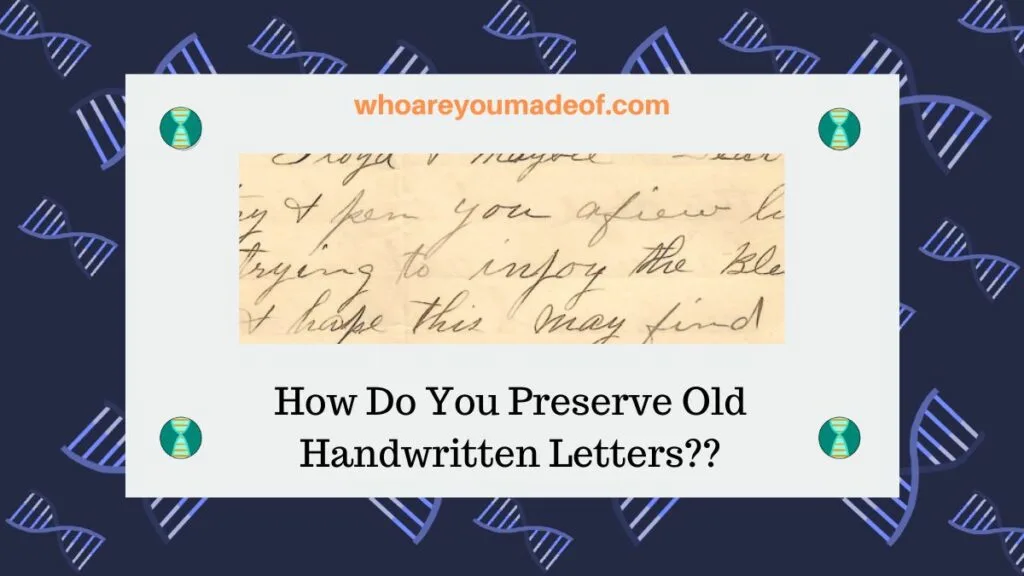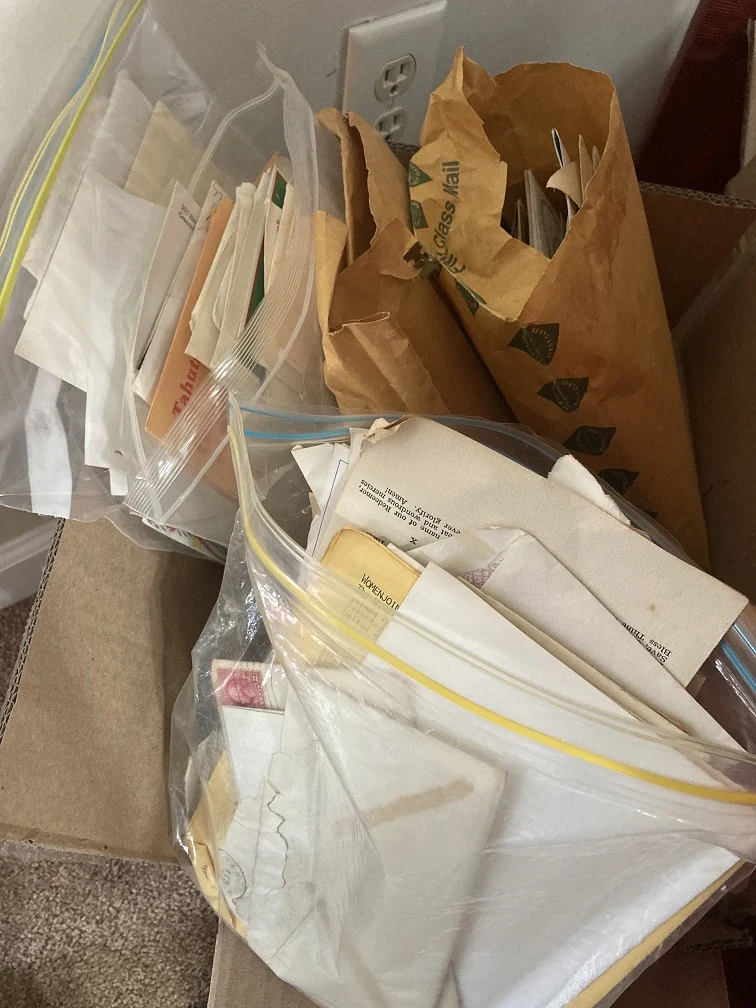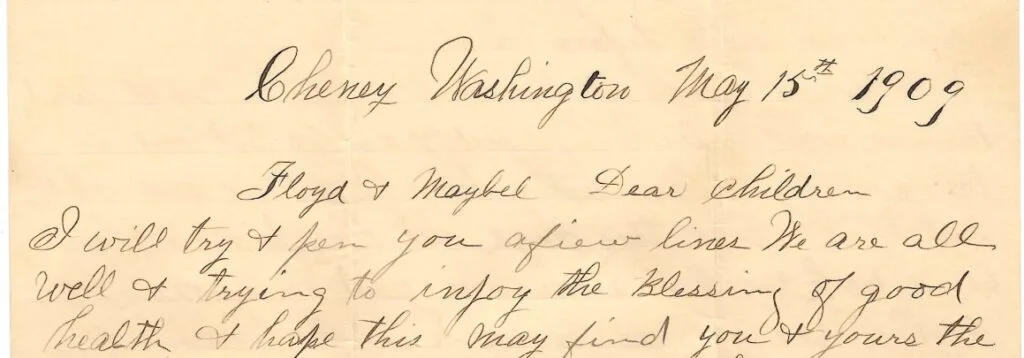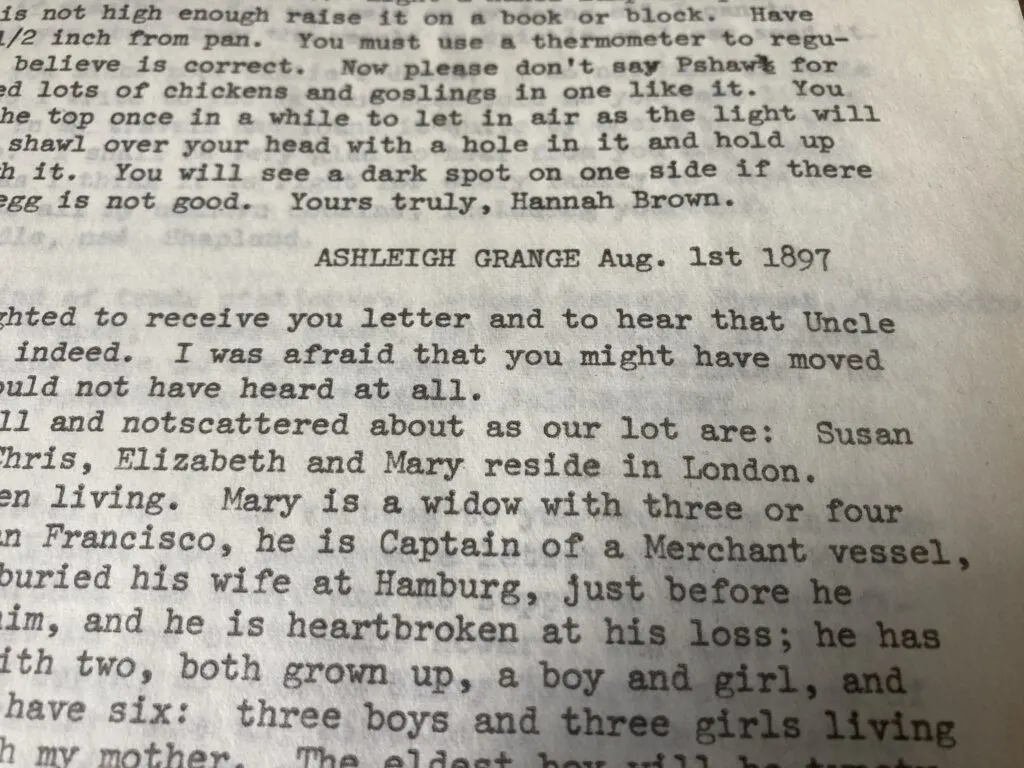Do you want to know the steps to take to preserve old handwritten letters? In this post, learn what you should do to save protect this history for generations to come.

As some of you might know, especially if you subscribe to my newsletter, a cousin gave me several boxes of family history research. These boxes include lots of pedigree charts, some sources, documents, photographs, but also many, many letters.
I've gone through and sorted out all of the handwritten letters into a collection, of sorts. They are currently in a big cardboard box, which is not an ideal long-term storage plan, and so my project now is to begin the process of preserving them.

The vast majority of the letters are from the 1940s - 1980s, which I realize is quickly becoming ancient history. As the saying goes, the days are long, but the years are short.
There are also several dozen letters in that box that are older than 1900. These letters cannot (and should not) be handled many more times, which is why I decided to go through the process of preserving all of these artifacts of family history.
Why we should save old handwritten letters
Historical letters offer an in-depth look into the daily lives, inner thoughts and feelings, communities, cultural norms, and important events as experienced by the letter writer. This is information that cannot be found anywhere else in the historical record, and so it has unique value to the family historian and for history in general.
Those of us who are working on our family trees will be able to find details about our family that could never be discovered any other way than through a letter written by someone who was living through an experience. For example, I knew from vital records, a very important type of genealogy record, that my 3rd great-grandfather had moved back to Illinois before his second wife died in Washington State.
I, somewhat naively, couldn't figure out why an elderly married couple in the early 1900s would live their last few years in separate parts of the country. However, within some of these old letters was a letter written by one of my great-great-great aunts describing the situation and defending her father's decision to move back to Illinois.
As it turns out, our ancestors long ago were just as subject to being human as we are today.
Most old letters are handwritten, since the typewriter was not widely commercially available until about the 1880s. Furthermore, even when they were available for purchase, typewriters were expensive, and so most people wrote personal correspondence by hand.
While these handwritten letters can often be tough to decipher, they often reveal more about the letter-writer than a typed letter would. So, if you find yourself in the possession of handwritten letters, consider yourself very fortunate indeed.
How to preserve old letters
Fortunately, the process to preserve old letters is easy enough to follow. It is also well-worth effort.
My strategy is to make sure that these letters are safe for many generations to come, yet accessible, enjoyable, and useful for those members of my family who are currently interested in reading them. I am still actively using these letters for genealogy, and so I want to make sure that I can reference them as needed.

Below are the steps to follow to preserve your letters using this method.
Get your supplies and tools
The first step is go gather the supplies that you will need to keep your letters safe. These supplies will include:
- Archival acid-free sheet protectors
- Archival sleeves for documents
- Archival folders
- Archival document boxes
- Binders
- Printer and paper
- Scanner or high-resolution camera
- USB drive, computer, or cloud storage for backing up scanned letters
My strategy is to store each individual letter in its own acid-free archival sleeve. Alternatively, if you don't want to buy so many archival sleeves, you could also consider instead using acid-free tissue paper between pages.
If it is within your budget, the archival quality polyester sleeves can be purchased through reputable vendors for a little over $1 each (such as this 100-pack for about $121). These sleeves are very high-quality and are good enough to store documents for hundreds of years, which is of course what we are hoping will happen.
In addition, I am also using acid-free sheet protectors, which cost about $10 for 50, to store the scanned copy of the letter in a binder, which you will learn more about below. So, depending on how many letters you have, you could need a large number of sheet protectors.
I want to preserve my copies in a way that can last a long time, too, so that no one is tempted to handle the letters more than necessary in the future.
Sort your letters
In this step, you should decide how you want to sort your letters. This will help you do your archiving process in an order that makes sense to you, and in a manner that will make your final result easier to organize.
For example, do you have lots of letters from only one person? If so, then you might consider simply organizing your letters in chronological order.
If your letters are from many people over a long period of time, you might consider dividing your letters into different lines of the family. For example, I have a package of letters written to my great-grandparents from all of the cousins in my dad's extended family from the 1970s-1990s.
One way to organize these letters could be to divide them into four groups (my great-grandparents had four kids), and then put them into chronological order. This would provide a nice "story" to the future reader because events and people would be easy to keep track of.
There are many ways to sort and organize your letters, so just pick what makes the most sense to you.
Scan the letters before preserving
In this step, we will make sure that we have a nice, open space to work with our letters and clean hands. We want to open the letters very carefully, scan the letter and the envelope, and then place both the letter and then envelope into an archival sleeve.
It is important to scan or take a good photograph of the letter before storing it. Ideally, the letter is never removed from the archival sleeve ever again, forever.
This means that our one chance to scan it as a PDF or image and get a copy of the letter is before we put it in the sleeve. It is also important to store the envelope, which is why I recommend also taking a scan of the envelope.
When you make the scan, it is a good idea to label the file with some sort of naming system for your letters. It could be as simple as "Letter from Sarah Smith to Lara Smith June 1944".
A final note about storing the letters in the sleeves: It's important to unfold the letters before storing them. Anyone who has opened a very old letter knows that the stress of the folds takes its toll on the paper, which means that it can only be folded and unfolded so many more times before it starts falling apart.
Storing the letter unfolded will help it last much longer.
Store them in sorted groups
Once your letters are scanned and placed into the sleeves, you can then store them sorted into smaller groups in archival folders. Those folders can be stored in archival document boxes.
The completely archived collection of letters should be stored in a safe place that is not too humid and that is not likely to be damaged by water or sun in the future. This means that the basement or garage are off limits for long-term storage of important documents like these.
Make an index to your box
It is a good idea to make a handwritten or typed index for each box of letters. This will help you, or someone else in the future, know exactly what is contained in the box.
This step is important to me because I want to make sure that my descendants, or whoever it is that takes up the family history torch in my family, understands how important these letters are. One of the first steps to helping them take care of the documents is to make it easy for them to know what they are without having to open them up and handle them.
Store the printed, scanned letters in a binder
This step is optional, but I suggest it if you have the time. My method includes printing out the scanned copy of the letters and keeping them in a binder.
I can use these copies to make a transcription, share with family, and refer to during my genealogy research.

The image above is from a transcription that my great-grandmother made from a package of letters from the 1890s that her aunt sent her that were written from various cousins to her grandfather. I am very appreciative of this transcription because it means that I will have to minimally handle the letters, which are very fragile at this point, in order to store them.
Make an index to your binder
It will make your life much easier if you make an index to the letters in your binder, even though it will be a little more work. If you made one for your archived document box and you are putting them in the binder in the same order (recommended), then you can just make a copy of this index to use for the binder.
You can now read about different ways to share your old letters!
Conclusion
I hope that this article has helped you understand more about why we should make an effort to correctly preserve our family's old handwritten letters, and exactly how to go about doing it. This is such a valuable part of your family history, and it's great that you want to take steps to make they are available for future generations.
If you have any questions about something that you read in this post, or if you would like to share details about a group of letters you would like to preserve, I would love to hear from you in the discussion below.
Thanks for reading today!

Benedicta
Tuesday 9th of May 2023
Hi, I am interested in how you preserved these letters of your family. I would like to find out, perhaps if you find yourself with handwritten letters sent from different people to one particular person. How do you sort them out?
what are the possible proposals you will suggest to sort them out.